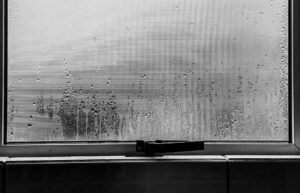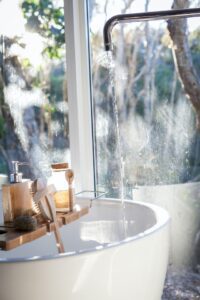 Conservatories can feel like a luxurious addition to any home, but that doesn’t mean they don’t come without the occasional concern. If you notice your conservatory double glazing misting up, there may be a problem with your windows or frames.
Conservatories can feel like a luxurious addition to any home, but that doesn’t mean they don’t come without the occasional concern. If you notice your conservatory double glazing misting up, there may be a problem with your windows or frames.
Condensation on the outside of your windows is normal – and it means your windows are working. Some condensation on the inside of your windows can be expected if you have poor ventilation around your conservatory, especially if you’re cooking or drying clothes in the area. The main issue we’re covering here is when you find condensation building up in that gap between your window panes. This needs fixing, and should be dealt with as soon as possible to avoid further damage.
Here’s our guide on what condensation in your conservatory double glazing means, and how you can fix it.
Why Windows Mist Up
First of all, we’ll look into why windows mist up. In most windows (in England, at least!) the outdoor air is colder than the air inside your home. This means the surface temperature of your windows is also colder. You then have this contrast between the room temperature air inside the home, and the cold temperature of the surface of your windows. Because conservatories are primarily made up of windows, they can be prone to condensation.
Condensation looks like a misted or cloudy window, and can obscure your view of the outside world whilst also making your home look less appealing. If you notice you do have misted windows, this may mean your double glazing has ‘failed’.
Any gaps in the sealant around your double glazed conservatory windows can allow this warm air from inside your room to enter that gap in between your window panes. Usually, there is an insulating gas inside there, but if the sealant isn’t holding it in, you will lose this additional layer of insulation. As the warm air enters this space instead, it forms water vapour as it comes into contact with the cold air of the surface of the window. This is the main reason double glazed conservatory windows mist up.
What Condensation in Your Window Means
If your conservatory windows do have condensation, this means your double glazing has likely failed. You may not have condensation on all your windows, so there may just be a few that need fixing.
It’s easy to brush aside the issue of condensation on your conservatory windows; especially if it doesn’t bother you that much. However, as condensation grows, so does the potential for damp and mould to form in your conservatory.
As we mentioned earlier, conservatories usually add that extra something to your home – but if it’s covered in mould and damp, it can essentially become inhabitable. This happens to a lot of conservatories, when owners don’t realise the extent of the lasting damage that can be caused by failed double glazing.
In the colder months especially, you want to be making sure your double glazing is properly insulating your home – and your conservatory! Make a point of checking your windows are in full working order every few months. Condensation can seep in slowly, and before you know it, you’re in need of a full de-moulding session. One of the most irritating things about damp and mould is that it does easily spread to surfaces beyond your windows.
Any soft furnishings, damp walls, and even your family members using your conservatory, can be harmed by these mouldy conditions. This moisture can also spread to the window frames, which over time can lead to more repair work being necessary in order to have your windows fixed. It’s best to check your double glazing is working regularly and avoid the often-disastrous impact of mould further down the line.
How to Avoid Condensation in Your Windows
To avoid condensation in your windows in the first place, there are a few things you can try. Sometimes, failed double glazing is inevitable. Nothing lasts forever, and you may have had your conservatory for a while. As weather, age, and other factors beyond your control all have an impact on the quality of your conservatory windows, sometimes they do just need replacing. To try to avoid condensation, you can have a go at these tips:
- Open your windows every day.
This improves circulation throughout your conservatory, so warm or moist air isn’t so stagnant and can flow around. - Use an extractor fan or dehumidifier to remove warm, moist air.
This is especially useful if your conservatory is next to a kitchen, as is often the case. Cooking creates a lot of warm and damp air that we often don’t realise can really contribute to condensation in other areas of the home. Try to also cover your pans and pots with their lids to reduce the moisture in the air. - Vent your tumble dryer properly.
Again, moist and warm are are often the culprits when it comes to condensation and failed double glazing. Make sure your tumble dryer’s vent is properly secured to flow out of the home. Check things are sealed correctly and ensure repairs are done before you use it. - Avoid drying damp clothes in the conservatory.
It may be tempting, as that warm sunlight seems like it will help dry clothes faster when the weather is a bit temperamental outside! However, the damp moisture from clothes needs to go somewhere as your laundry is drying. This is often evaporated into the air, and if you have failed double glazing, it will add to the level of condensation in your windows.
The most effective way to rid your conservatory of condensation is to have your double glazing properly checked and fixed.
What You Should Do
Finally, here’s what you should do if you find condensation in your conservatory windows! There are the few tips above that can help you avoid getting that condensation in the first place, but often you will need a proper fix in order to make sure your double glazing remains working on top form.
While the issues with condensation and double glazing may sound like a pain, it’s important to recognise that condensation does happen much more frequently on single window panes. Double glazing is still your best bet if you’re looking to keep your home warm, insulated, more secure, and even sound-proofed!
Call Cloudy2Clear now on 0800 61 21 119 for a free, no obligation quote. We work to fix conservatory windows all over the UK, operating in over 35 areas across the nation. We use the most eco-friendly methods to restore windows to their former glory; only using the materials necessary to fix your double glazing. This has that added benefit of making your repairs cheaper, too.
You can also contact us via our online form. Ask any questions you may have about how we can help deal with your condensated conservatory, and we’ll get back to you as soon as we can.
 Double glazing has numerous benefits for both you and your home – not to mention your bank balance. Some of these include insulation, energy savings, noise prevention, and a condensation-free appearance; but what happens when double glazing fails?
Double glazing has numerous benefits for both you and your home – not to mention your bank balance. Some of these include insulation, energy savings, noise prevention, and a condensation-free appearance; but what happens when double glazing fails? Condensation isn’t rare. Many homeowners therefore tend to overlook it when it appears on their windows. Condensation can form on any cool surface, and we see it every day. You probably notice water droplets forming on other surfaces in your bathroom after you have a hot shower – like mirrors, tiles, and shower panels.
Condensation isn’t rare. Many homeowners therefore tend to overlook it when it appears on their windows. Condensation can form on any cool surface, and we see it every day. You probably notice water droplets forming on other surfaces in your bathroom after you have a hot shower – like mirrors, tiles, and shower panels. Having double glazing installed is one of the best ways to improve insulation in your house. This can be a worthy investment, especially with winter approaching and energy bills on the rise.
Having double glazing installed is one of the best ways to improve insulation in your house. This can be a worthy investment, especially with winter approaching and energy bills on the rise. Bathrooms are often a problem area for those struggling with damp in the home. They’re usually the smallest rooms in the house, yet they’re equipped with plenty of utilities that create steam and lead to condensation on a daily basis.
Bathrooms are often a problem area for those struggling with damp in the home. They’re usually the smallest rooms in the house, yet they’re equipped with plenty of utilities that create steam and lead to condensation on a daily basis. Many of the first signs of condensation and damp within a bathroom begin with the windows. You might start to notice puddles of water forming around the windowsill or mould starting to grow.
Many of the first signs of condensation and damp within a bathroom begin with the windows. You might start to notice puddles of water forming around the windowsill or mould starting to grow. A key step in improving the security of your home is your front door. As the main entry to your house, it’s often the first thing any criminals will target when trying to enter your property. The good news is, there are now plenty of front door security considerations you can think about installing to keep your house safe.
A key step in improving the security of your home is your front door. As the main entry to your house, it’s often the first thing any criminals will target when trying to enter your property. The good news is, there are now plenty of front door security considerations you can think about installing to keep your house safe.
